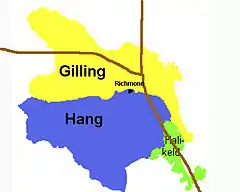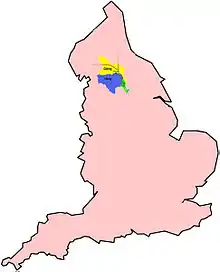Honour of Richmond
The Honour of Richmond (or English feudal barony of Richmond) in north-west Yorkshire, England was granted to Count Alan Rufus (also known as Alain le Roux) by King William the Conqueror sometime during 1069 to 1071, although the date is uncertain. It was gifted as thanks for his services at the Conquest. The extensive district was previously held by Edwin, Earl of Mercia who died in 1071. The district is probably mentioned in the Domesday Book of 1086 but its limits are uncertain.[1]
The honour comprised 60 knight's fees and was one of the most important fiefdoms in Norman England.[2] According to the 14th-century Genealogia of the lords of Richmond, Alan Rufus built a stronghold in the district. The buildings were later known as Richmond Castle which is alluded to in the Domesday survey as forming a ‘castlery’.[3]
Territory
 The composition of the Honour of Richmond in 1071 |
 The location of the Honour in England |
The district consisted of three main land divisions; the wapentakes of Hang, of Gilling and of Hallikeld. The first two of these correspond to later medieval civil land divisions or wapentakes: the third is less easily defined.
The Gilling territory consisted mainly of land which lay between the River Tees and the River Swale, with the Tees forming the northern border which separated the land from that granted to the Bishop of Durham. The western border was the watershed of the Pennine Hills and the southern border was the watershed between the River Ure and the Swale. The River Wiske formed the eastern border. The manor of Gilling, close to the boundary, was the caput of the barony until Count Alan moved it to Richmond Castle. The division of Hang, or Hangshire, had the River Swale as its northern boundary; its western boundary was the Pennine watershed and its southern boundary was the watershed with the River Wharfe and the River Nidd. The eastern border followed small streams and minor landmarks from the previous watershed to the Swale. The wapentake meeting place was situated on the Hang Beck in Finghall parish. The third part of the territory, Hallikeld, consisted of the parishes lying between the River Ure and the River Swale until their confluence at Ellenthorpe.
The Honour of Richmond, being 60 km (37 mi) from east to west and 45 km (28 mi) from north to south, comprised most of the land between the River Tees and the River Ure and ranged in its landscape from the bleak mountainous areas of the Pennines to the fertile lowlands of the Vale of York.
Richmond castle was in ruins by 1540 but was restored centuries later and is now a tourist attraction.[4]
List of feudal barons of Richmond
The feudal barons of Richmond were usually referred to as Lords of Richmond. The Honour of Richmond was sometimes held separately from the titles Earl of Richmond, and later Duke of Richmond. Grants were sometimes partial, and sometimes included or excluded Richmond Castle as noted in the list below. The descent of the barony was as follows:[5]
- Alan Rufus, Count of Brittany (d.1093), who died without progeny.
- Alan the Black (d.1098), brother of Alan Rufus, who also died without progeny.
- Stephen, Count of Tréguier (d. 1135/6), brother.
- Alan, 1st Earl of Richmond (d.1146), (alias Alan The Black, or le Noir), younger son.
- Conan IV, Duke of Brittany (d.1171), son, who left as his heir a daughter Constance (d.1201),[6] a ward of the king.
- Held in wardship by King Henry II pending the marriage of his son Geoffrey to Constance, the daughter of Conan IV
- Constance, Duchess of Brittany (d.1201),[6] Conan's daughter and hereditary Countess of Richmond
- Geoffrey II, Duke of Brittany(d.1186) first husband of Constance[6]
- Ranulph, Earl of Chester (d.1232), second husband of Constance, whom she married in 1188 and whom she divorced in 1199.[6][lower-alpha 1]
- Guy of Thouars – third husband of Constance; forfeited to King John in 1203[6] upon taking up arms with the French to avenge the death of Arthur I
- Alix, Duchess of Brittany (d. 1221), Constance and Guy's elder daughter.[lower-alpha 2]
- Eleanor of Brittany, Constance and Geoffrey's elder daughter.[lower-alpha 3] She ceased to be styled as Countess of Richmond in 1218.
- Peter I, Duke of Brittany (alias Pierre Mauclerc), the husband of Alix of Thouars and the son-in-law of Guy of Thouars and Constance of Brittany. He declined an offer of the Honour and the Earldom of Richmond from King John (1199–1216) due to his loyalty to the French King. He received in 1218 from William Marshal, 1st Earl of Pembroke in name of King Henry III a partial grant of the Honour, excepting 30 knight's fees south of the River Trent retained by the king,[6] His lands were forfeited to King Henry III when he paid homage to French King Louis IX. Thus his tenure of the barony varied according to his allegiance in the war between England and France.[6]
- William of Savoy, Bishop elect of Valence, granted the Honour in August 1236.[7]
- Peter II, Count of Savoy, popularly known as Earl of Richmond, to whom the barony was granted by King Henry III in 1240.[6] He sought and received a royal confirmation of his holding in 1262. He had felt his tenure at risk due to the negotiations for the marriage of Beatrice, daughter of King Henry III to John, son of John I, Duke of Brittany (d.1286) who was son of Alix, Duchess of Brittany. A part of this marriage settlement stipulated that his father the duke should receive French lands equal in value to the honour of Richmond.[6] He lost control of the barony in 1264, although he received income from it until 1266, when the barony was granted to John of Brittany, husband of Beatrice.[6]
- John II, Duke of Brittany (d.1305), husband of Princess Beatrice.[6]
- John of Brittany, Earl of Richmond (d.1334), son. He died unmarried without progeny.[6]
- John III, Duke of Brittany (1286–1341), nephew
- John de Montfort, Earl of Richmond – upon his death, Earldom returned to the crown in 1342; it remained with the crown during most of the Breton War of Succession in part to ensure it would not fall into the hands of the King of France.
- John of Gaunt – surrendered the Earldom and Honour, at the insistence of the King, to pursue Kingship of Castille
- John IV, Duke of Brittany, son and heir of John of Montfort; forfeited twice, in 1381 (due to the First Treaty of Guerande) and 1384 upon paying homage to French King Charles VI; the second forfeit represented the permanent loss of the Honour and the Earldom by the Dukes of Brittany.
- Anne of Bohemia
- Ralph de Neville, 1st Earl of Westmorland – Honour held for life without peerage Earl of Richmond
- John of Lancaster, 1st Duke of Bedford and 1st Earl of Richmond
- reverted to the Crown (1435–1450)
- Ralph Neville, Earl of Westmoreland – partial grant of Richmond Castle in 1450
- Edmund Tudor, 1st Earl of Richmond – father of Henry VII
- Henry Tudor – forfeited to Edward IV
- George Plantagenet, 1st Duke of Clarence – granted Honour and castle without peerage Earl of Richmond by Edward IV in 1462
- Richard, Duke of Gloucester – retained upon becoming Richard III of England
- Henry Tudor – regained the Honour upon winning the crown of England in contest with Richard III; Honour merged with the Crown
- Held by members of Tudor and Stuart Dynasties
- Charles Lennox – conferred on Lennox Family in 1675 by Charles Lennox's father Charles II
Notes
- However, Ranulph never ruled Richmond or Brittany during their marriage.
- A charter made by Alix before her marriage to Peter I deals with the Honour of Richmond; Alix also styled herself Countess of Richmond before her husband received the Earldom from King Henry III. See Judith Everard and Michael Jones, The Charters of Duchess Constance and Her Family (1171–1221), The Boydell Press, 1999, pp 169–171.
- Although King John allowed her to use the titles Duchess of Brittany and Countess of Richmond, she was imprisoned by English kings and never ruled. See Judith Everard and Michael Jones, The Charters of Duchess Constance and Her Family (1171–1221), The Boydell Press, 1999, pp 164–165.
References
- "THE HONOUR AND CASTLE OF RICHMOND". British History. 1 March 2016. Retrieved 12 January 2019.
The date of the grant is uncertain, and no charter remains to bear witness to it. The most likely date in that case would seem to be 1069, when Edwin was still living ... If the evidence of the so-called charter is inaccurate on this point as on others the grant may have been delayed until after the death of Edwin in 1071.
- Butler, Lawrence (2003). "4.The origins of the honour of Richmond and its castles". In Robert Liddiard (ed.). Anglo Norman Castles. Woodbridge, Suffolk: The Boydell Press. pp. 91–95. ISBN 0-85115-904-4.
- "THE HONOUR AND CASTLE OF RICHMOND". British History. 1 March 2016. Retrieved 12 January 2019.
... the early poem which contains the first mention of it yet discovered says that William the Conqueror gave Count Alan Richmond 'a good castle fair and strong.' (fn. 259) This statement may, however, be due to poetic licence.
- "HISTORY OF RICHMOND CASTLE". English Heritage. 1 March 2016. Retrieved 12 January 2019.
By 1540 the castle was derelict, but it later became a popular tourist destination.
- Sanders, I.J., English Baronies, A Study of their Origin and Descent 1086–1327, Oxford, 1960, pp.140–1, Barony of Richmond
- Sanders, p.140
- CPR Henry III Vol 3 1232-1247. 156.